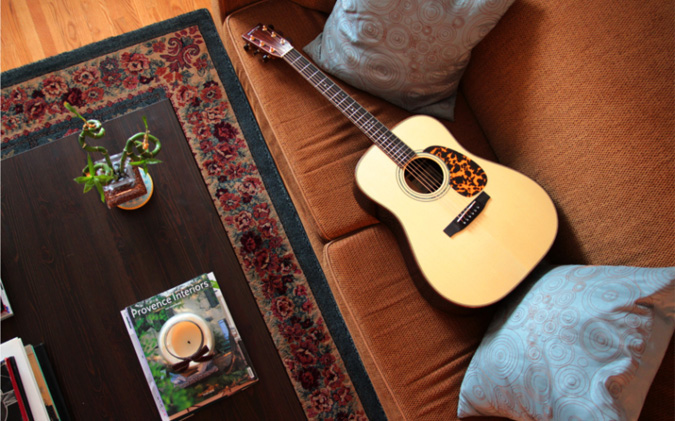Furch Musical Instruments (Stonebridge) has been building acoustic guitars in the Czech Republic for over thirty years. The owner, František Furch, is a self-taught guitar builder and entrepreneur who began learning his craft under the restrictive Communist regime and, against the odds, succeeded in turning Furch into a brand that is recognized internationally amongst acoustic guitars nerds. On top of the underdog story, Furch is also the only guitar manufacturer in the world using a secret micro-enzyme in production.
When Furch started building guitars in 1981, the state owned Československé Hudební Nástroje (the collective of Czechoslovak Musical Instruments) was the only legally sanctioned guitar builder. ČSHN produced all of the classic Czechoslovak guitar brands, most notably Jolana Guitars.
As a passionate bluegrass musician, Furch was frustrated with the low quality of instruments available to him, and he longed for the Gibsons and Martins of the West. With no other option than to make one on his own, he embarked on a new journey with no experience and very limited knowledge. He read books, evaluated the construction of other instruments, and watched educational shows. Through trial and error, Furch first built a banjo followed by a round back acoustic guitar in the classic plastic Ovation style.

Its quality far surpassed that of ČSHN and the word of mouth started to spread. Soon, Furch was adorned with a small underground following and Czechoslovak musicians were longing for him to build them a custom guitar. He continued to build guitars in the family garage until after the Velvet Revolution. In 1990, Furch Musical Instruments officially started marketing and selling their guitars. Through the 1990s, Furch steadily grew in the Czech Republic as well as key international markets including Germany, Japan and the United Kingdom. By the end of the 90s, this Czech guitar maker had already made massive strides, growing from one custom banjo to thousands of units, but had not yet made the jump to the biggest guitar market in the world – North America.
In 2004, Roger Schmidt, a Canadian music instrument sales representative, approached Furch. Roger believed that the quality was the best among guitars in the price range, but felt that the original name would not resonate with the North American market; he decided to rebrand Furch Guitars to Stonebridge Guitars, after the famed Charles Bridge. This partnership has doubled the growth of Furch/Stonebridge sales, as well as the brand’s exposure.
Building high-end acoustic guitars is an enormous undertaking, and the process is laborious and time consuming; I designed for Washburn Guitars when the custom shop was starting their USA acoustic guitar production. This 30 million dollar company, with full-time luthiers (a term that originally referred to lute makers and that has been adopted by modern guitar builders to describe their craft) was only able to reach an output of three guitars a day.
What does it take to build?
Machines and molds (or jigs) used in production are custom built for the exact specifications of each guitar’s body style. The wood is hand selected for tonal qualities; different woods are picked for the top, back, and sides of the guitar. For steel string guitars like Furch, the most common woods used for the top are spruce and cedar, both valued for their strength, resonance, and workability. Rosewood, maple, and mahogany are usually used for the back and sides. The wood has to cure in climate-controlled dry rooms for up to several years. Once dried, the sides are lightly sprayed to re-moisturize them and allow the wood to be bent by the jigs, creating the signature curves. Afterwards, the bracing system is added by gluing thin, crafted strips of wood onto the top of the guitar. This pattern not only strengthens the top but also functions as an integral part of the guitar’s tone because it channels the airflow within the body. At this stage, the guitar is still far from being finished; it still needs to be fitted with the neck, fretboard, bridge, finish and various other elements. This is what Frantisek Furch had to teach himself using limited resources of Communist Czechoslovakia.
The micro-enzyme
Apart from their unique story, what makes this Czech Guitar maker different from other guitars? Enter the mysterious mad scientists behind the sound of the Furch Guitar. They implemented a top-secret process licensed by a Swiss-based laboratory, during which an organic micro-enzyme is applied to the spruce top of the guitar. The top is then placed into a moisture rich incubator for four months. Within this time, the organic micro-enzyme breaks down the wood’s natural membranes and resins, opening the capillaries within the wood and creating a more resonate tonal quality. In effect, this process ages your guitar 90 to100 years in four months. This is an incredible advantage, as most musicians are looking for vintage instruments that have fuller, warmer, and more resonate tones. Such vintage quality normally comes at a price; pre-war Martins sell for tens of thousands of dollars. This is not the case with Furch. At the time of writing this article, Furch/Stonebridge is the only guitar manufacturer in the world using this aging technique, the details of which are their closely guarded secret.
I first encountered Furch guitars back in 2008 at the Musikmesse in Frankfurt, the largest instrument tradeshow in the world. As my wife is Czech, I immediately gravitated towards Furch to see what they are all about. I was blown away by the quality, finish and precision of the instruments’ craftsmanship. Guitarists can understand that a truly great instrument has a soul you can sense through the vibrations, and the invisible connection you feel towards it as it becomes an extension of yourself.
You create an instant attachment and love for the guitar and you never want it to leave your side. The Furch I played that day had this quality and I wished I owned that guitar right away. I am not the only one; musicians such as Glen Hansard or Susanne Vega have chosen Furch/Stonebridge. Acoustic Guitar Magazine has praised the guitars for their “clean looks, great craftsmanship, and lovely tones.”
If you desire to play one of these beauties and hear for yourself, you only have one option in the Czech Republic at the:
Fuch showroom in Brno
Zelný trh 10, 602 00 Brno
Hours: Monday – Friday, 10:00 – 18:00.
The guitars range in price from 1,600 to 4,999 USD.
Related articles












 Reading time: 5 minutes
Reading time: 5 minutes 






































